quash, or hobak, an everyday food that reminds us of family dinners from childhood, is widely used for side dishes as well as a staple.Squash is versatile, giving not only its flesh but also its seeds, flowers and vines for food.
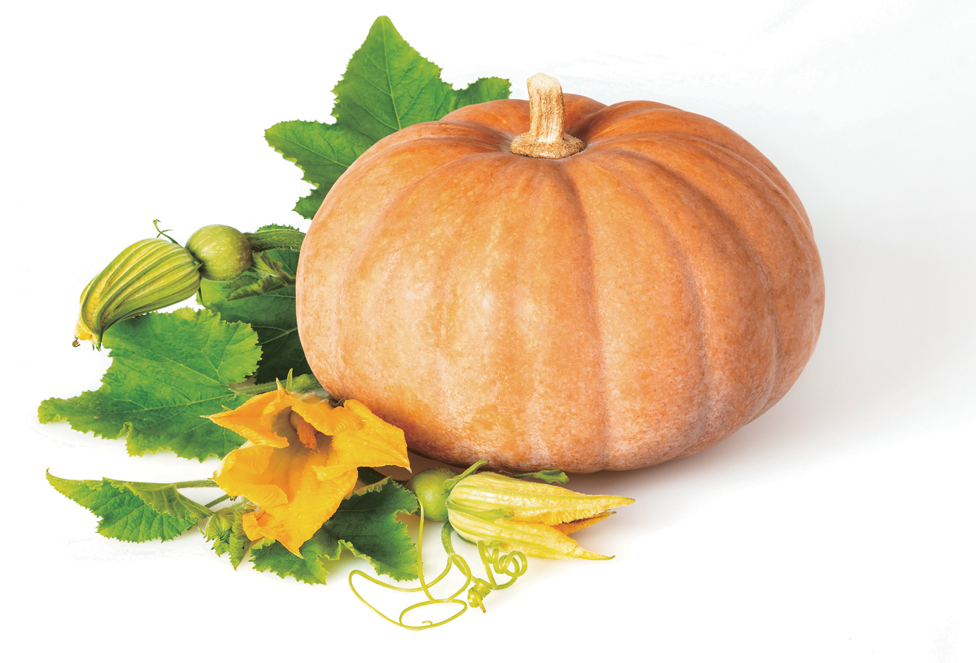
Aged squash eaten in autumn and winter is a familiar food ingredient to Koreans. It is used to make porridge with sticky rice flour, and its juice is drunk by mothers who have just given birth to reduce postpartum swelling. © imagetoday
With the changing of the seasons, the type of squash we eat changes, too. Soft squash with its thin skin is eaten in summertime, and squash with yellow flesh that has the taste and texture of sweet potato inside a thick, hard skin is for wintertime. But this seasonal distinction based on the harvest time does not always apply.
For example, Koreans distinguish between aehobak, young green squash also known as Korean zucchini, and neulgeun hobak, literally “aged squash,” but they may either be of the same or of different species. In the old days, the young, light-green Korean summer squash and the aged, yellowish-brown squash that grows as big as a rugby ball until autumn were of the same kind. These days, however, most of the aged squash is of a completely different kind, like cheongdung hobak, the fully ripened pumpkin with a hard, orange skin. The popular danhobak (literally “sweet squash”) variety, which is pushing aged squash to the sidelines, can now be purchased throughout the year, but when it comes to taste, texture and storage time, it is considered to be winter squash.
Motifs of Pictures and Stories
Apart from the seasons, another sort of time is found in squash. When squash appears as the subject of paintings, it provides us a clue as to when the paintings were d. “The Pumpkin” (a.k.a. “Giant Squash from the Ducal Gardens of St. Francis in Pisa”) by the Italian artist Bartolomeo Bimbi (1648–1729) features a huge squash weighing about 80 kilograms set against a dark, stormy sky. Records say that two strong men were needed to transport the squash to the artist’s studio and that onlookers followed them, clapping their hands.
The squash in the painting, however, is not particularly big compared with the giant squashes today. The world record squash, harvested in Belgium in 2016, weighed 1,190.5 kilograms. At any rate, we can infer that the painting was made no earlier than the 16th century, based on the squash appearing in it. Originating in South America, squash had been grown since around 5000 B.C., but it was not introduced to Europe on a wide scale until the 16th century. Indeed, Bimbi painted his squash in 1711. “Vertumnus” by Giuseppe Arcimboldo (1526–1593), an artist from Milan, is a portrait of the Holy Roman Emperor made up of various fruits and vegetables, including squash. Painted around 1590, it features squash as a crop from the New World along with maize.
Squash began to appear in stories around the same time. The scene in “Cinderella” where the fairy godmother magically changes a pumpkin into a golden carriage may seem to be part of an old story, but it was actually added to an orally transmitted story in 1697 by the French writer Charles Perrault. Squash also appears in Shakespeare’s “The Merry Wives of Windsor,” written around 1597. In the play, Mistress Alice Ford compares Falstaff, a womanizer and glutton, with “this unwholesome humidity, this gross watery pumpkin.” In Europe, where people had not yet become used to squash, a big, old pumpkin might have been an apt description for a fat, self-centered character. While natives in the Americas loved pumpkin so much that they held a festival in its honor, European emigrants to the American continent despised pumpkin as food for poor country folks.
Food in Memories
In Korea, people often compare an ugly person with a squash. Novelist Park Wan-suh (1931–2011), however, regarded squash rather differently. She said that when she saw lustrous young squash, pinched in the middle, she would buy them automatically, without thinking what to cook with them. Also, at the sight of round native, young squash peeking through the vines climbing up a neighbor’s wall, she was tempted to stealthily pick one. What she really loved, though, was not just the squash but the squash leaves. In her prose collection “Homi” (Hand Hoe), she writes:
“The fresh squash leaves are washed clean after the rough stem running along the vein has been peeled off. While they are being steamed on top of cooked rice till they become limp, soybean paste sauce is made in an earthen pot. The soybean paste has to be tasty. Scoop up a spoonful and put it in the pot without straining it, add a drop of sesame oil, chopped garlic and cut green onion, add some milky water left over from washing rice and boil the mixture for a while, then add as much chopped green chili as there is soybean paste, and boil it again. This will make it thick. For tastes which have grown more perfidious today, you can add some crushed dried anchovies for flavor, and also steam the squash leaves in a steamer instead of laying them on top of cooked rice.”
Squash leaves are a seasonal delicacy that can be enjoyed from summer until late autumn, when cold winds begin to blow. The contrast in the flavor and texture of spiced soybean paste sauce and cooked rice wrapped in the tender but crunchy leaves is so delectable that it is hard to stop eating. “Finally, one feels satisfied and relaxed as if reaching the end of longing,” as Park Wan-suh put it. For her, the taste was a reminder of her hometown half a century earlier, the humble dinner table, the walls covered with climbing vines, the vegetable garden and the platform for crocks holding sauces and condiments, and the sense of relief and weariness upon arriving home at last.
The squash is a food that evokes memories for people around the world. It is hard to imagine Provence without ratatouille cooked with squash. In Italy, eating young squash flowers is a tradition, and “The Fruit Seller,” painted by Vincenzo Campi (1536–1591) in the late 16th century, shows edible squash flowers along with other fruits and vegetables. In Central and South America, where squash originated, squash flowers have been part of people’s diets for a long time.In Mexico, squash blossom soup and squash blossoms stuffed with Oaxaca cheese are popular dishes.
A food of memories, squash is also accommodating to current trends. Low in fat and calories, and with ample protein, carbohydrates, vitamin A, potassium and fiber, squash allures modern people struggling to control their weight. One of the latest trends is eating zucchini noodles made with a spiralizer instead of flour noodles, but spaghetti squash, whose flesh dissolves into spaghetti-like strands when cooked, has already existed for decades.
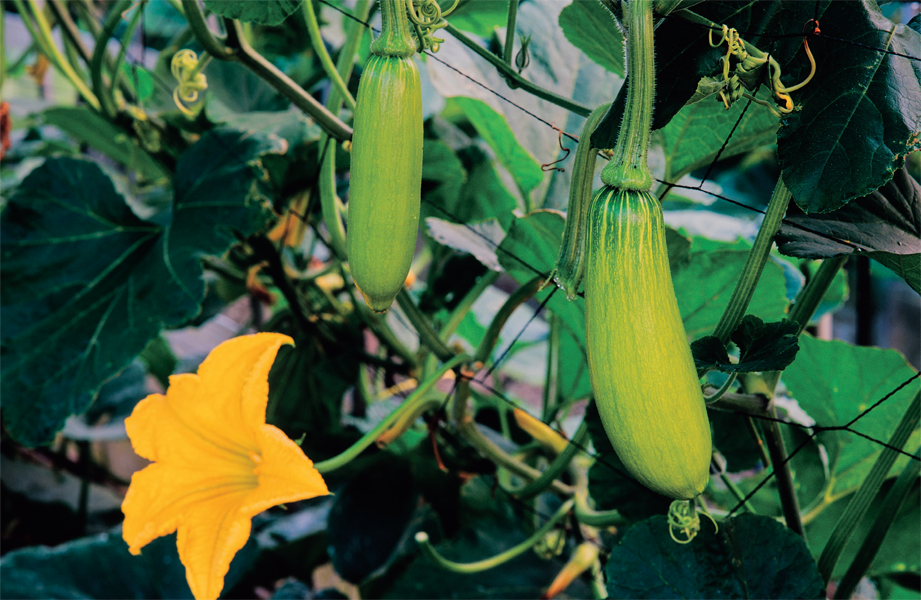
The cheap and tasty young green squash, enjoyed in summer, is versatile as its leaves are also a well-loved food. The soft leaves are steamed or parboiled to wrap around rice with a dollop of seasoned soybean paste.© Getty Image
Often cooked in soybean paste stew and used as garnish for noodle dishes, squash also tastes wonderful when cut into thin slices, coated with flour and egg, and pan-fried.
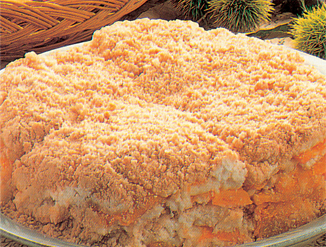
Squash rice cake made by steaming a mixture of rice flour, aged squash flesh, salt and sugar is a popular treat.
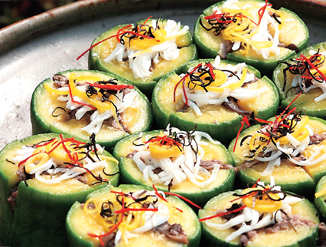
Hobakseon is made in various ways depending on region, but one common way is to make cuts in pieces of young squash, stuff the cuts with seasoned fillings and then steam them before eating. This recipe can be found in old cookbooks.
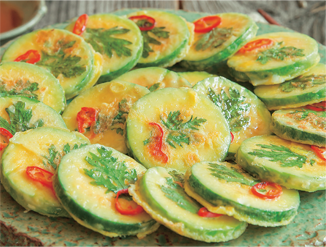
The recipe for hobakjeon is so simple that the dish can be easily made at home. Young green squash is cut into slices, coated with flour and egg, and then pan-fried.
Seasonal Delicacies
Summer squash are especially diverse in kind. Not only is there the lengthy green zucchini but also the yellow zucchini with the same shape but the flavor of a mushroom. These days, summer squash is available throughout the year, but it tastes best in summer. Squash picked when it is young and small, about 15–20 centimeters long, is sweeter as it is less watery. Often used in soybean paste stew and as garnish for noodle dishes, squash also tastes wonderful when cut into thin slices, coated with flour and egg, and pan-fried.
Squash is also great for savory dishes. “Siui jeonseo” (A Compendium of Proper Recipes), a 19th-century book of recipes and table settings of the late Joseon period, introduces a recipe for steamed squash with garnish, called “hobakseon.” Young squash the size of a fist is cut in horizontal lines on the back and steamed, and the cuts are then stuffed with minced beef stir-fried with green onion, garlic, pepper, oil and honey, and garnished with various mushrooms, such as shiitake, oyster mushrooms and manna lichen, with shredded red pepper and fried egg strips. This dish still stands comparison with any food on the dinner table today, which many try to re. Squash sliced and stir-fried with salted shrimp and perilla oil is one of Koreans’ favorite squash recipes.
Compared with summer squash, which can be stored for only a brief time, winter squash has a high starch content that allows it to be stored for several months. When butternut squash is slowly cooked over a long time, the glutamic acid is dissolved, resulting in a more savory taste. In the West, pumpkin is an ingredient for pies, tarts and soup, and in Korea, pumpkin porridge is eaten as a snack. Pumpkin is also tasty when roasted in the oven and dribbled with honey or simply steamed.
Park Wan-suh said that comparing an ugly person with squash comes from the ignorance of city people. The longer we keep squash in our diets, the more we will agree with her.
Jeong Jae-hoonPharmacist and Food Writer